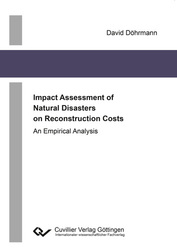| Departments | |
|---|---|
| Book Series (96) |
1378
|
| Nachhaltigkeit |
3
|
| Gesundheitswesen |
1
|
| Humanities |
2364
|
| Medienwissenschaften | 16 |
| Theology | 57 |
| Philosophy | 102 |
| Law | 422 |
| Economics | 850 |
| Social sciences | 416 |
| Sports science | 48 |
| Psychology | 233 |
| Educational science | 190 |
| History | 182 |
| Art | 111 |
| Cultural studies | 166 |
| Literary studies | 116 |
| Linguistics | 88 |
| Natural Sciences |
5406
|
| Engineering |
1793
|
| Common |
98
|
|
Leitlinien Unfallchirurgie
5. Auflage bestellen |
|
Advanced Search
Impact Assessment of Natural Disasters on Reconstruction Costs (English shop)
David Döhrmann (Author)Preview
Table of Contents, PDF (110 KB)
Extract, PDF (380 KB)
In recent decades the frequency and severity of natural disasters increased. This development is accompanied by an increase in catastrophe related economic losses and is assumed to continue for the foreseeable future if effective disaster mitigation efforts are omitted. Due to the massive destruction of physical assets the basis for economic losses are generally reconstruction costs, which must be raised after a catastrophe to restore the original state of buildings and infrastructure. Thus, the need for reconstruction together with the financial influx from disaster relief and insurance payouts might create a boom. As a consequence some economic sectors might even experience positive effects after natural disasters, e. g., retail and construction.
| ISBN-13 (Hard Copy) | 9783736990197 |
| ISBN-13 (eBook) | 9783736980198 |
| Final Book Format | A5 |
| Language | English |
| Page Number | 170 |
| Lamination of Cover | glossy |
| Edition | 1. Aufl. |
| Publication Place | Göttingen |
| Place of Dissertation | Braunschweig |
| Publication Date | 2015-06-09 |
| General Categorization | Dissertation |
| Departments |
Economics
Political economics Insurance industry |








